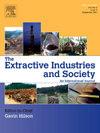Environmental and mine closure costs in the block sequencing of a coal deposit
IF 3.6
2区 社会学
Q2 ENVIRONMENTAL STUDIES
Extractive Industries and Society-An International Journal
Pub Date : 2025-04-18
DOI:10.1016/j.exis.2025.101668
引用次数: 0
Abstract
At present, extractive industries face significant sustainability challenges in the territories where they operate. Traditionally, environmental and social variables have not been integrated into the processes of optimization and sequencing in mining plans, leading to outcomes that are not holistic and are accompanied by higher risks. Efforts to reduce geological, economic, and operational uncertainty have seen considerable progress in recent years. However, limited research addresses the environmental and social uncertainties that mining projects may face. This research proposes the internalization of the costs associated with the closure of the mine, environmental costs and costs of conflict resolution, calculated based on equations suggested by various authors in the state of the art. The base case of an open pit coal mine located in Colombia with previously established initial conditions and associated costs, calculated after the optimization process, is addressed. Subsequently, a new case is generated in which these costs are charged to the economic valuation of the mineral, punishing its calorific value. At the end, a sensitivity analysis is carried out with the future projections of the price of coal. The results obtained indicate that, by internalizing these costs, it is possible to reduce the investment risk and there is an improvement in the operational, social and environmental performance of the case study. Results that could benefit the company, the State and the communities.
煤矿区块排序中的环境和矿井关闭成本
目前,采掘业在其经营的地区面临着重大的可持续性挑战。传统上,环境和社会变量没有纳入采矿计划的优化和排序过程,导致结果不全面,并伴随着更高的风险。近年来,减少地质、经济和运营不确定性的努力取得了相当大的进展。然而,有限的研究涉及采矿项目可能面临的环境和社会不确定性。这项研究建议将与关闭矿山有关的费用、环境费用和解决冲突的费用内部化,这些费用是根据各种作者在最新技术中提出的方程式计算的。以哥伦比亚某露天矿为例,在优化过程后计算了初始条件和相关成本。随后,又产生了一种新的情况,将这些费用计入矿物的经济估价,惩罚其热值。最后,对未来煤炭价格的预测进行了敏感性分析。所获得的结果表明,通过将这些成本内部化,有可能降低投资风险,并改善案例研究的业务、社会和环境绩效。可以使公司、国家和社区受益的结果。
本文章由计算机程序翻译,如有差异,请以英文原文为准。
求助全文
约1分钟内获得全文
求助全文
来源期刊

Extractive Industries and Society-An International Journal
ENVIRONMENTAL STUDIES-
CiteScore
6.60
自引率
19.40%
发文量
135
 求助内容:
求助内容: 应助结果提醒方式:
应助结果提醒方式:


